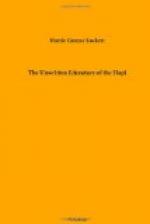“Their prayers had been answered. The spell of the drouth-evil had been broken, and the long strain of the solemn ceremonial gave place to such a carnival of rejoicing as it seldom falls to the lot of civilized man to see....
“From the white man’s point of view, this answer to prayer was, of course, the merest coincidence, but not all the power of church or government combined could convince the Hopi that their god had not heard them ... that their devotion to the ancient faith had brought relief from famine, and life to themselves and their flocks and herds.”
The present-day Hopi, including the most intelligent and best educated of them, will tell you, that all their important dances and ceremonials follow faithfully the old traditions, and are still believed to be efficacious and necessary to the welfare of the people. And this has been the conviction of a majority of the scientific observers who have studied them.
=Other Dances=
There is a very definite calendar arrangement of these ceremonials, some variation in the different villages, but no deviation in the order and essential details of the main dances.
In December comes the Soyaluna, or winter solstice ceremony, to turn the sun back from his path of departure and insure his return with length of days to the Indian country. Good-will tokens are exchanged, not unlike our idea of Christmas cards, at the end of the ceremony; they are prayer tokens which are planted with prayers for health and prosperity. The kiva rituals are rich in symbolism and last eight days, if young men are to be initiated, otherwise four. The public dance at the end is a masked pageant.
In January comes the Buffalo Dance, with masks representing buffalo, deer, mountain sheep, and the other big game animals. Its chief characters are the Hunter and the Buffalo Mother, or Mother of all big game. A prayer for plentiful big game is the idea of this dance.
In February the Powamu, “bean sprouting,” ceremony occurs, with very elaborate ritual signifying consecration of fields for planting. Various masks and symbolic costumes are used, and the children’s initiation is accompanied with a ceremonial “flogging”—really a switching by kachinas. Dr. Dorsey considers this the most colorful of all Hopi ceremonies and says that nowhere else on earth can one see in nine days such a wealth of religious drama, such a pantheon of the gods represented by masked and costumed actors, such elaborate altars and beautiful sand mosaics, nor songs and myths sung and recited of such obvious archaic character, containing many old words and phrases whose meaning is no longer known even to the Hopi themselves.
March brings the Palululong, “Great Plumed Serpent,” a masked and elaborately costumed mystery play given in the kiva. This shows more of the dramatic ability and ingenuity of this people than any other of their ceremonies; the mechanical representation of snakes as actors being one of its astonishing features.




